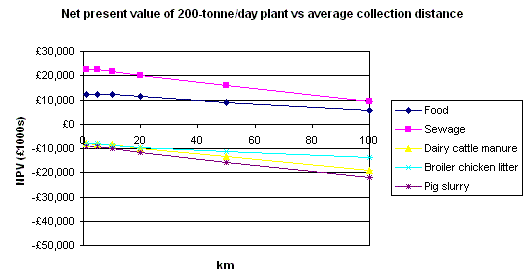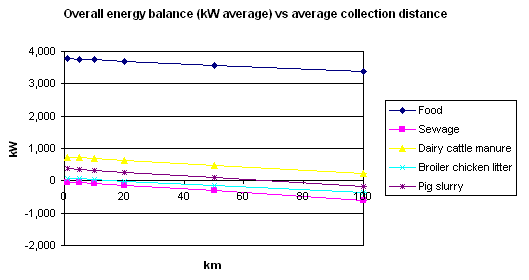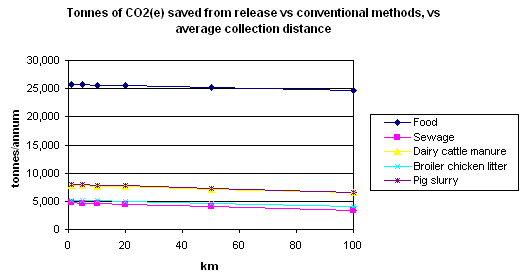Case Study
General conclusions from case study analysis using the calculator
|
The general conclusions from the case study and model validation exercises are:-
- That almost all digestion plants and feed stream combinations provide beneficial energy balances. The energy produced in the CHP engine outweighs the energy required to transport the feed & digestate and to operate the plant. Remember, our calculations do not account for energy requirements related to construction and maintentance of the plant and vehicles, or the commuting requirements of employees.
- That all digestion plants and feed stream combinations provide beneficial CO2e greenhouse gas emission balances. The benefits are dominated by the prevention of methane release from naturally occuring biodegredation of the feedstocks that occur if the plant is not operated. The methane is approximately 25 times more effective at absorbing infra-red radiation than CO2 as a greenhouse gas.
- That the most favourable digestion plant revenues arise from gate fees for waste that would otherwise have been landfilled (eg municipal food waste, and biosolids from sewage treatment plants). Gate fees for these substances are currently estimated at £35-70 per tonne due to the landfill directive. This is a substantial change from historic landfill costs which have been in the £13-14 per tonne range. Revenues from electricity and heat sale at £0.04 and £0.003 per kWh respectively do not alone provide enough revenue to offset plant construction, running and transport costs. There appears to be no substantial market for the digestate fertiliser due to its bulky (wet) nature and associated transport cost. The digestate does have value as the N, P and K content values are favourable. To date this has value only been successfuly demonstrated with co-operative plants where the farmers providing the manure feeds also pick up the digestate free, but the farmers have some financial stake in the farm - they pay indirectly for the digestate.
Experiment to discover the viable transport distances for different feedstocks
|
To augment these conclusions, a final interesting experiment adds clarity and understanding. A digestion plant of 200 tonne/day capacity is imagined. Into this, we examine the financial, energy and CO2e balance which results from using various single feedstock types, which are each transported from varying distances. The feedstock types which are analysed are:-
- The hotel operates its own sewage treatment plant. We assume a sewage throughput equivalent to our hotel "population" of 600.
- The "population" of 600 produces food waste. We assume this to be at the normal domestic food waste rates (between 0.2 and 0.7 kg/person/day, with an expected value of 0.3 kg/person/day). At the hotel, this food waste must be gathered by source-separating food waste from the kitchens and other staff/guest residences. Depending on how efficiently the kitchens manage their food wastage, the actual food waste quantities might be towards the upper, 0.7 kg/person/day levels.
- There are 20 horses in livery stables on the estate. These provide for equestrian activities. Although only 20 horses are present, they account for a relatively high proportion of the waste tonnage as each horse can be expected to produce between 30 and 55 kg/animal/day. The dryness and biogas yield from this manure can vary widely however, depending upon how it is gathered (water used for hosing down etc.) and how much straw bedding/feed is mixed in with the manure.
| % Dry solids | Biogas yield m3/tonne | C:N ratio |
| Municipal source-separated food waste | 15-23 | 70-160 | 23.3 |
| Municipal sewage plant biosolids | 2.5-5 | 9-20 | 7.8 |
| Dairy cattle manure | 6-14 | 12-40 | 19 |
| Broiler chicken litter | 30-65 | 50-100 | 11.4 |
| Pig slurry | 3-11 | 20-28 | 10.8 |
Assumptions for the Experiment
|
For the experiment, we also assume a few other details similarly to the case studies. Gate fees (for food and sewage) apply at £45/tonne. Digestate is sold at a nominal £2/tonne, and is transported at the cost of the buyer (although we account for the digestate transport energy to a fixed distance of 10km). There is no capital grant available, so the entire plant cost must be covered by generated revenues. Electicity and heat are sold at £0.04 and £0.003 per kWh respectively. Discount rate is 8%, with the capital paid back over 10 years. The plant lifetime is 20 years.
Plants processing municipal and sewage waste are extremely viable. This because the £45 per tonne gate fee is a massive dominant financial effect. It is interesting to note that the plants are still financially viable when these feedstocks are transported over 100km to the plant! Common sense and environmental impact of the transport should preclude these long-distance activities, however.
Plants processing the other feed stock types are not financially viable under the assumed conditions, even over short distances. There are a number of factors which could be adjusted in future to make these types of plant independently financially viable without grant funding:-
- Finding a successful market for the digestate, even a small increase from £2/tonne to £4-5 per tonne would have a large effect, since every tonne processed by the plant produces digestate.
- Reducing transport costs, by piping manure feeds from neighbouring farms, can dramatically increase profitability.
- Plant capital costs are currently modelled by chemical engineering principles for one-off plant designs. This follows closely with current practice where no two plants are the same. A more consistent plant design, of a more off-the-shelf or modular design might dramatically recuce plant capital cost.

It is interesting to note the poor predicted performance of chicken litter here. In some respects, this is a misleading result. Chicken litter us about 50% dry solids by mass. When used as a single feed stream, this dry feed would be better processed by incineration, as is the current practice for chicken litter. In this experiment, to achieve a 10% dry solids feed to the digester, 40 tonnes/day of chicken litter had to be watered down with 160 tonnes/day of water. This repesents very poor use of the chicken litter and the digester. In addition, the chicken litter alone has a poor C:N ratio of about 11. Chicken litter is a very effective input to an anaerobic digester, but only as part of a mixed waste stream. The chicken litter is a useful thickened for wetter substances like pig slurry (7% dry) and human sewage (3% dry), allowing a mix of approximately 10% dry solids to be achieved without adding any water. The C:N ratio can also be manipulated upwards towards the optimum 20-30 by adding other feed types.
The energy balance of all feed stock processing, apart from sewage biosolids, is positive over sensible collection distances less than 20km.

Processing sewage biosolids does not present a net energy gain even when the feed can be collected from very close to the plant. This is because the sewage alone is very wet (about 3% dry solids) so the digester sizes are large relative to the volatile material processed; heat losses are correspondingly large compared to the biogas yield and the plant can barely export any energy. Also, the C:N ratio of the biosolids is very poor at about 8. As mentioned above, however, combining sewage biosolids at 3% dry, with chicken litter at 50% dry, can produce a mixture at 8-12% dry which is optimum for digestion and such a plant could provide a positive energy balance. Mixing sewage with other feed types to raise the overall C:N ratio into the 20-30 range will also have a massive beneficial effect on the energy balance.
Municipal source-separated food waste is extremely effectively processed from an energy perspective. The food waste is relatively dry (20% dry solids) so incurs little transport cost per volatile solids transported. The feed is watered down on site and this water does not incur transport penalties. The food waste alone has a good C:N ratio of about 23 which is in the optimum 20-30 range. Biogas yields are good, and transport energy is relatively small. This leads to a good energy balance, even if the municipal food waste is transported from over 100km away! Again, common sense and environmental impact of the transport should preclude these long-distance activities, however.
The effects of the plant on global greenhouse gas emissions via the CO2ecalculation are very similar to the energy balance effects described above, and for the same reasons.

Conclusions for the future of Anaerobic Digestion of waste.
|
Considering all the evidence and results obtained, the following conclusions for the future of anaerobic digestion of waste streams can be drawn:-
- Mixed waste stream plants, when operated with suitable mixes of feedstock which allow 8-12% dry solids and C:N of 15-30 to be achieved, provide a positive energy balance and effect on greenhouse gas emissions, when the feedstocks can be sourced from less than 20km distant. The energy and CO2e balance for food can still be beneficial even with much larger transport distances. Intermediate feedstocks such as chicken litter, catlle manure etc can provide beneficial energy and CO2e balances over larger collection distances than 20km, depending on the properties of the overall feed mix.
- Mixed waste plants which process food and sewage wastes can be extremely profitable. This is driven by the £35-70 per tonne gate fee that the wastes incur. Anaerobic digestion of municipal source-separated food waste combined with sewage biosolids will be a cost-effective and profitable way of dealing with these waste streams. The digestion plants should be located as close to sewage plants as possible since the sewage digestion is not viable from an energy point of view unless the transport costs are minimised - prefereably by piping the sludge rather than using vehicle transport. Food waste can be transported from relatively large distances and still provide positive financial, energy and greenhouse gas emission benefits.
- Plants processing predominantly agricultural manures (which incur no gate fees), will be financially marginal or unprofitable unless plant costs can be minimised, capital grants are available, or a more lucrative market for the digestate can be created. Plant costs could be minimised by a more consistent plant design or modular construction methods.
| 
